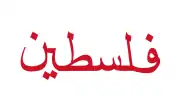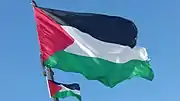Flag of Palestine
The flag of Palestine (Arabic: علم فلسطين) is a tricolor of three equal horizontal stripes (black, white, and green from top to bottom) overlaid by a red triangle issuing from the hoist. This flag is derived from the Pan-Arab colors and is used to represent the State of Palestine and the Palestinian people. It was first adopted on 28 May 1964 by the Palestinian Liberation Organization.
 | |
| Use | National flag |
|---|---|
| Proportion | 1:2 |
| Adopted | 28 May 1964 (PLO) 15 November 1988 (State of Palestine) |
| Design | A horizontal tricolour of black, white, and green; with a red triangle based at the hoist |
.svg.png.webp) Variant flag of the State of Palestine | |
| Use | Presidential standard[1] |
| Proportion | 1:2 |
| Design | A horizontal tricolour of black, white, and green; with a red triangle based at the hoist charged with the national emblem above two crossed white swords in the upper hoist corner |
The flag is almost identical to that of the Hashemite Kingdom of Hejaz, which is the western portion of the Arabian peninsula, and the Arab Socialist Ba'ath Party (both use a 2:3 ratio as opposed to the Palestine's 1:2) as well as the short-lived Arab Federation of Iraq and Jordan (which had an equilateral triangle at the hoist). It is also very similar to the Flag of Jordan and Flag of Western Sahara, all of which draw their inspiration from the Arab Revolt against Ottoman rule (1916–1918). The flag of the Arab Revolt had the same graphic form, but the colours were arranged differently (white on the bottom, rather than in the middle).
Origin

| Part of a series on |
| Palestinians |
|---|
 |
| Demographics |
| Politics |
|
| Religion / religious sites |
| Culture |
| List of Palestinians |
The flag used by the Arab Palestinian nationalists in the first half of the 20th century is the flag of the 1916 Arab Revolt. The origins of the flag are the subject of dispute and mythology. In one version, the colours were chosen by the Arab nationalist 'Literary Club' in Istanbul in 1909, based on the words of the 13th-century Arab poet Safi al-Din al-Hili:
Ask the high rising spears, of our aspirations
Bring witness the swords, did we lose hope
We are a band, honor halts our souls
Of beginning with harm, those who won't harm us
White are our deeds, black are our battles,
Green are our fields, red are our swords.
Another version credits the Young Arab Society, which was formed in Paris in 1911. Yet another version is that the flag was designed by Sir Mark Sykes of the British Foreign Office. Whatever the correct story, the flag was used by Sharif Hussein by 1917 at the latest and quickly became regarded as the flag of the Arab national movement in the Mashriq.[2]
On October 18, 1948, the flag of the Arab Revolt was adopted. A modified version (changing the order of stripes) was officially adopted as the flag of the Palestinian people by the Palestine Liberation Organization (PLO) in 1964. On November 15, 1988 the PLO adopted the flag as the flag of the State of Palestine.
On the ground the flag became widely used since the Oslo Agreements, with the establishment of the Palestinian Authority in 1993. Today the flag is flown widely by Palestinians and their supporters.[3][4][5]
Ban
In 1967, immediately following the Six-Day War, the State of Israel banned the Palestinian flag in the occupied Gaza Strip and West Bank. A 1980 law forbidding artwork of "political significance" banned artwork composed of its four colours, and Palestinians were arrested for displaying such artwork.[6][7][8]
Since the signing of the Oslo Peace Accords in 1993, the ban has been abolished.
Historical flags
 Flag used during the 1936–1939 Arab revolt
Flag used during the 1936–1939 Arab revolt Flag used by the Arab League to represent Palestine from 1945 to circa 1955[9]
Flag used by the Arab League to represent Palestine from 1945 to circa 1955[9] Flag used by the All-Palestine Government, similar to the Flag of the Arab Revolt
Flag used by the All-Palestine Government, similar to the Flag of the Arab Revolt Version with shorter triangle, used by the Palestine Liberation Organization until the 1980s
Version with shorter triangle, used by the Palestine Liberation Organization until the 1980s
Gallery

.jpg.webp) Man waving a Palestinian flag.
Man waving a Palestinian flag.
 A pro-Palestinian banner at a demonstration in Trafalgar Square, London.
A pro-Palestinian banner at a demonstration in Trafalgar Square, London._12.JPG.webp) Demonstrators during a rally in Ljubljana protesting 2014 Israel–Gaza conflict.
Demonstrators during a rally in Ljubljana protesting 2014 Israel–Gaza conflict..jpg.webp) A large Palestinian flag in Barcelona.
A large Palestinian flag in Barcelona. Two Palestinian flags flying.
Two Palestinian flags flying. Neturei Karta ultra-orthodox Jews with Palestinian flags.
Neturei Karta ultra-orthodox Jews with Palestinian flags. A Palestinian girl wearing Palestinian flags in a protest on Nakba Day 2010 in Hebron.
A Palestinian girl wearing Palestinian flags in a protest on Nakba Day 2010 in Hebron. Palestinian supporters in Nicaragua with a Palestinian flag.
Palestinian supporters in Nicaragua with a Palestinian flag. Israeli and Palestinian flags sewn together. Credit: Lance Trumbull - EverestPeaceProject.org.
Israeli and Palestinian flags sewn together. Credit: Lance Trumbull - EverestPeaceProject.org. Gaza supporters in Turkey waving Palestinian flags with a Turkish crescent.
Gaza supporters in Turkey waving Palestinian flags with a Turkish crescent. Protesters in Anaheim with Palestinian flags during Operation Cast Lead, 2009.
Protesters in Anaheim with Palestinian flags during Operation Cast Lead, 2009..jpg.webp) An IDF soldier confronts a man with a small Palestinian flag during demonstrations in Bil'in.
An IDF soldier confronts a man with a small Palestinian flag during demonstrations in Bil'in.
See also
Notes
- Breschi, Roberto. "PALESTINA - Bandiera del presidente". Bandiere - Passato e Presente (in Italian). Retrieved 31 July 2019.
- Tamir Sorek, The orange and the ‘Cross in the Crescent’: imagining Palestine in 1929, Nations and Nationalism, Vol 10 (2004) 269-291.
- United Nations Security Council: The situation in the Middle East, including the Palestinian question (S/PV.5077 Archived 2008-06-02 at the Wayback Machine)
Mr. Terje Roed-Larsen, Special Coordinator for the Middle East Peace Process and Personal Representative of the Secretary-General: "[Arafat] with the trademark kaffiyeh epitomized Palestinian identity and national aspirations, even more than the Palestinian flag or the national anthem." - Flags of the World: Palestine
Quote: "The Palestinian flag represents all Palestinian Arab aspirations regardless of party." - AmericanDiplomacy.org: Palestinian Psychological Operations: The First Intifada by Jamie Efaw
Quote: "An example of a common, obvious symbolism came in the form of the Palestinian flag. [...] the flag and the colors transmitted the message to all target audiences the underlying theme of the entire Intifada—Palestinian nationalism. The flag, the symbol of Palestinian nationalism, was ubiquitous in the occupied territories." - Kifner, John (October 16, 1993). "Ramallah Journal; A Palestinian Version of the Judgment of Solomon". The New York Times. Retrieved May 21, 2010.
- Dalrymple, William (October 2, 2002). "A culture under fire". The Guardian. London. Retrieved May 21, 2010.
- "The watermelon makes a colourful interlude". The Age. Melbourne. September 12, 2004.
- Breschi, Roberto. "Palestina". www.rbvex.it. Retrieved 25 July 2019.
External links
| Wikimedia Commons has media related to National flag of Palestine. |
